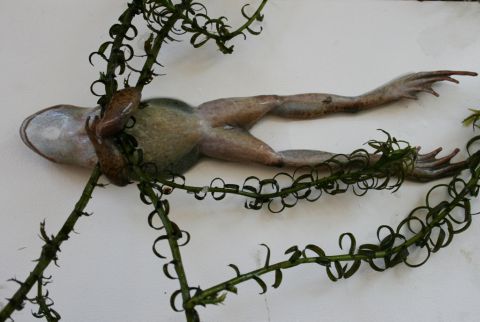A hazy blue stillness. Nothing moves. Until a sudden ripple disturbs the soupy water, stirs the suspended particles. Powerful legs propel the creature through the water and paddle madly as the alarmed frog attempts to secrete itself in a dark crevice. Panic subsides; danger has passed and the frog allows itself to hang in the water, recovering, before its strong legs push off again into deeper water and the cover of thick weed. Nearby, clusters of lustrous jelly eggs float just beneath the surface. In a matter of days, each egg’s black nucelus grows and changes and tiny embryos begin to wriggle in the thick mucous, waiting for the right time for their release.
In an article for Scientific American entitled Are Viruses Alive? Professor Luis P. Villarreal wrote,
“What exactly defines “life?” A precise scientific definition of life is an elusive thing, but most observers would agree that life includes certain qualities in addition to an ability to replicate. For example, a living entity is in a state bounded by birth and death. Living organisms also are thought to require a degree of biochemical autonomy, carrying on the metabolic activities that produce the molecules and energy needed to sustain the organism. This level of autonomy is essential to most definitions.”
A chance encounter with a dead frog discovered in my pond reminds me of the connection between electricity and life and the work of Luigi Galvani who experimented with the effects of electricity on dead tissue, famously making dead frogs’ legs kick in response to electrical charge.
NOW medics routinely shock people back to life using defibrillators.
[A voice from the future says, “Can you believe that once people were thought to be dead just because their heart stopped beating?”]
Sadly my frog is definitely, permanently dead.
NEXT – Trying to activate my stone






